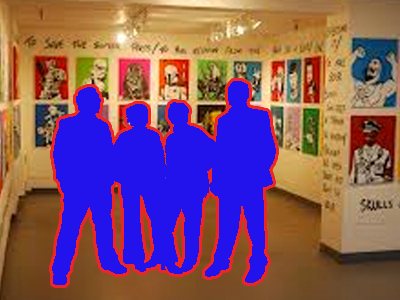 This year’s Community Scholars class is broken into five project teams, each working on some aspect of the theme of a green economy.
This year’s Community Scholars class is broken into five project teams, each working on some aspect of the theme of a green economy.
Last quarter we did a work-in-progress presentation to an audience of “clients” and other interested parties. All the content was great, but listening to five projects in succession is a little hard on an evening audience of people who have been working all day. People were engaged. But they were also tired and had difficulty sustaining attention to projects that didn’t involve their particular interests. Such is life.
So this time we are experimenting with a “gallery” approach, to create a more festive space that is more about conversations than presentations.
Here are the basic steps to the approach:
1. Start with a Clear Goal
Yesterday’s goal was for each team to get feedback from all of the other team’s in the class. The goal was to solicit constructive criticism to help us produce the best possible products for our clients — to give them the best possible value added.
2. Set up the Room
In our case we had a variety of products to showcase: a marketing package for the Native Green gardeners coop that includes a website, brochure, and business cards; a poster that promotes a green policy strategy for building trade unions; a package of popular education products on health and nutrition for the Market Makeovers program; and a nifty little brochure that helps people figure out how to lower their utility costs with simple home retrofits that can be subsidized by the city; a curriculum for a leadership school for young workers; and storyboard illustrations for a cartoon on green jobs. (Stay tuned for the final products which will be available here in mid-June).
We set up tables around the room and close enough to the wall so that presenters could post information on the wall, and stand or sit behind the tables to explain their wares to viewers.
3. Provide Some Instruction
Let the audience know what you want from them. If you want feedback, create a way to capture that. In our class, one group created a place where people could anonymously write comments. Since our goal was to collect feedback of a work-in-progress, our instructions to the gallery-goers were as follows:
- Each team should select one person to staff their booth and present their project or product as people come by.
- Every other person in the class should take on the identity of someone who is writing a review of the gallery by answering the following questions:
- What really stood out as EXCELLENT? Why?
- Was there anything that was somewhat confusing or hard to understand? Describe that briefly.
- Do you have any concrete suggestions? Only answer this question if you actually have concrete suggestions. You can know that something doesn’t quite work without knowing how to fix it. (It is not your project, after all).
Here’s a link to the instructions we used in this particular class.
4. Synthesis
Depending on your goal, you may use different strategies to pull the results of the experience together.
Here is what we did:
- Each “reviewer” was given about 15 minutes to turn their observations into a one minute report-back.
- I solicited and recorded feedback one question at a time.
- We broke back into teams to discuss how to use the feedback we received.
